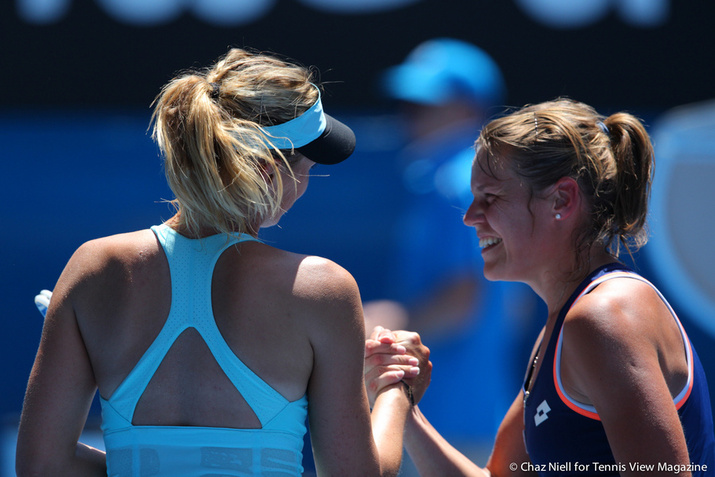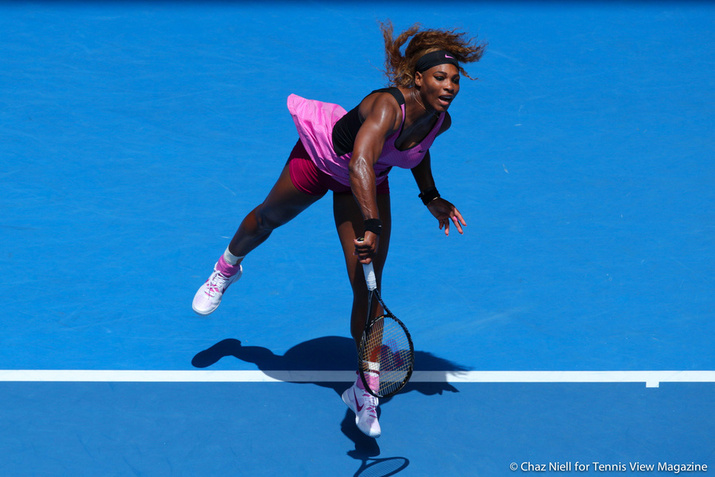Don't miss any stories → Follow Tennis View
Follow2014 Australian Open Report Card (WTA)
With the first major of the season behind us, the time has come to issue report cards for the best and the rest at the Australian Open. Ladies before gentlemen.

Li Na: Nothing but adversity and heartbreak had befallen Li in her two previous Australian Open finals, both of which she had seemed destined to win before snatching defeat from the jaws of victory. This year, the tennis gods must have chosen to reward her for persevering after those painful losses. Arranged before her was the most favorable route to a major final that one could imagine, trumping even Marion Bartoli’s path at Wimbledon last year. Li became the first woman to win the Australian Open title without facing anyone in the top 20, yet her run nearly ended before it began.
Buffeted around the court by Lucie Safarova in the third round, she watched helplessly as her opponent’s backhand dove toward the back of the baseline. Hawkeye showed that it fell two inches long, and the rest was history. Li rarely gave any of her four remaining opponents a flicker of hope that they could compete with her, much less win. Her second major title positioned her within range of joining Serena Williams in the top two. As the WTA places more and more of its eggs in the Asian basket, Li’s exploits could not have come at a better time. A+
Dominika Cibulkova: Many a talented woman has dazzled en route to her first major final, only to melt into a puddle of anxiety when she reaches it. The glare of the spotlight did not intimidate Cibulkova. any more than the prestigious opponents whom she had ambushed before then. At five feet three inches, the diminutive Slovak played with the ball-striking ferocity of a much taller woman. Her unshakeable belief lifted her past not only world No. 3 Maria Sharapova but world No. 5 Agnieszka Radwanska to earn her rendezvous with Li. And, like her fellow finalist, Cibulkova crushed most of her opponents with scorelines more expected from a Williams or an Azarenka. In four of her six victories, she lost three or fewer games.
Rising into the top 15 will give Cibulkova the chance to consolidate her Melbourne breakthrough. What she does during the upcoming season will decide whether this tournament was a serendipitous career highlight or the start of something special. We may not know yet, but we do know that the flame of ambition has ignited inside that tiny body. A+
Eugenie Bouchard: The era of the teenage prodigy may have faded, but it has not ended entirely. In her last major before her 20th birthday, Bouchard pounced on a dream draw to reach her first major semifinal in her first trip to the Australian Open. She might owe some flowers and chocolate to Ana Ivanovic for knocking off Serena Williams a round before and then coming up flat in their quarterfinal. Still, nobody but Bouchard deserves credit for the maturity that she showed in consecutive comeback wins on Rod Laver Arena, a stage where novices so often falter. Don’t be fooled by her photogenic blonde looks and fondness for stuffed animals. This Canadian nurtures as fierce an appetite for competition as any of her peers and already has honed the weapons needed to succeed at the top. A

Ana Ivanovic: Her tournament ended with anticlimax, but that’s not how it will be remembered. First came the comeback against Samantha Stosur, when Ivanovic showed resilience in shrugging off the loss of a first set fraught with drama and distractions. But everyone counted her out anyway against world No. 1 Serena Williams. That was a mistake, and not just because Serena’s back injury hampered her. Delivering the shock of the tournament, Ivanovic held her nerve without a tremor while returning the best serve in women’s tennis as dismissively as anyone ever has. Once she catches her breath from that astonishing burst of form, a new phase of her career might begin. A
Match of ages: The opening-round clash between 16-year-old Belinda Bencic and 43-year-old Kimiko Date-Krumm reminded many of us why we love this sport. Across three sets, the retro shot-making of the ageless Japanese woman dueled with the contemporary baseline power of the Swiss teenager. Many are the ways to win in tennis, and many are the types of personalities whom one finds in it. We’ll remember Date-Krumm long after she retires for good. The early signs are that we’ll remember junior No. 1 Bencic too. A-

The longest match: In plastic-melting heat, Karin Knapp stood toe to toe with Maria Sharapova for three and a half hours on Rod Laver Arena, defying a gap of over 70 rankings places. The Italian could have folded her tent as early as the second set, when Sharapova led by a set and a break. Knapp certainly could have yielded when the Russian marched to the brink of a double-break lead in the third. Hats off to her for not relenting until the 17th game of the final set, and to Sharapova for resisting the alliance of the pesky underdog and the Dantesque conditions. No heat could melt her inner ice. A-
Agnieszka Radwanska: The Tantalus of women’s tennis has eyed golden opportunities to break through at two of the last three majors, only to let them escape in painful ways. Radwanska seemed to have conquered her biggest obstacle when she upset world No. 2 Victoria Azarenka in the quarterfinals, much as she had at Wimbledon last summer when she outlasted Li. And make no mistake, that win struck a pivotal blow in a rivalry where Radwanska had looked lost for so long. Triumph turned to disaster, though, as she won only three games from Cibulkova in a matchup that favored her. The match-ending break at love exuded an air of fatalism from the best active player without a major title. A-/B+
Simona Halep: She had handled pressure with poise throughout her rise over the last year, so it was surprising to see her crumble in her first major quarterfinal. The comparison to Bouchard, playing in the same circumstances against a more dangerous opponent, did Halep no favors during her collapse against Cibulkova. That quarterfinal appearance did mark a milestone in itself, however, and she scored yet another upset over a top-10 opponent (Jelena Jankovic) to get there. B+

Flavia Pennetta: An otherwise dreadful tournament for seeded Italian women (see below) bore fruit for the 31-year-old veteran. Her first Australian Open quarterfinal appearance came at the expense of world No. 9 Angelique Kerber. Much the older of those two women, Pennetta looked physically and mentally fresher when their battle reached the cauldron of the third set. When she first returned from injury last spring, people wondered whether she would ever be the same. Since then? Three straight second-week appearances at majors, and a new lease on life. B+
Ekaterina Makarova: Halted one step short of a third straight Australian Open quarterfinal, she scored a strong comeback victory over Venus Williams in the first round. In general, though, Makarova is not someone who can topple an elite player in reasonably solid form. She has won 11 total games in her last three losses at the Australian Open, two to Sharapova and one to Li. B
Sloane Stephens: The last American woman standing in either draw, Stephens extended her streak of second-week appearances at majors to five. That achievement impressed even more in view of the pressure on her to defend semifinal points. Coach Paul Annacone must have been reasonably content with his charge’s effort in those circumstances, especially considering her age. The Azarenka matchup is kryptonite for Stephens, who couldn’t hit through her or outlast her any more effectively than she did last year. B
Victoria Azarenka: Gone within 24 hours of fellow defending champion Novak Djokovic, Azarenka suffered a similar setback against a player whom she had dominated. She won just one game in the two sets that she lost, not a worthy way for a world No. 2 to exit a major. Azarenka hasn’t played her best tennis since the first half of 2013, even though her results suggest otherwise. That serve, so far impervious to improvement, remains a millstone around her neck that puts pressure on the rest of her game. Indian Wells and Miami will be crucial events before the tour leaves her favorite surface. B-
Garbine Muguruza: Overshadowed by Bouchard’s breakthrough was her quieter but still notable surge. Muguruza will remember this month for a long time after she coupled her first title in Hobart with her first trip to the second week of a major. Few players have bounced back from surgery as quickly as the young Spaniard, whose groundstroke penetration rivals anyone in her generation. She also showed resolve in rallying from the brink of defeat to upset top-10 opponent Caroline Wozniacki. Skip a grade

Serena Williams: Another year, another disappointing end to an Australian Open campaign for a woman who once dominated Down Under. A five-time champion, Serena has gone four years without even reaching the semifinals there. The world No. 1, who will maintain her stranglehold over the top spot, cited a back injury after the loss. Certainly, Serena missed many more routine groundstrokes and returns of serve than she does at her best. But each of the last two seasons when she lost early at the Australian Open turned out well enough in the end. Doctor’s Note
Maria Sharapova: Rarely at her best during her four matches, Sharapova never looked like a true contender. This was understandable early in her return from a long injury absence. A hip injury appeared to trouble her during the three-set loss to Cibulkova, without which she might not have faded so meekly. (That said, the result looked much better when Cibulkova blitzed two more top-15 opponents in the next two rounds.) Her exit closely resembled Serena’s defeat in most key details, leaving the WTA wondering when its two biggest attractions will be healthy again. Incomplete
Caroline Wozniacki: Her first-week loss to a young slugger eerily resembled her loss at the US Open. Once again, Wozniacki seemed likely to survive the ebbs and flows across the net with unspectacular but steady play. Once again, she had no answer when the opponent found her range at crucial moments. Getting hit off the court by a Williams or Sharapova is one thing; getting hit off the court by a Giorgi or Muguruza is something else. But don’t jump to conclusions about the ability of Thomas Hogstedt to revitalize her. Hogstedt’s partnership with Sharapova needed time to mature before bearing fruit. C+
Sara Errani/Roberta Vinci: It’s not easy to be outstanding at everything all the time. Errani and Vinci pulled off that feat for most of 2012 and much of 2013, sharing the No. 1 doubles ranking while surging into the top 15 in singles too. The huge quantity of matches that they logged in the process has caught up with them, as anyone could have foreseen. Errani, who has admitted to struggling with burnout, may face a crossroads soon. Does she reduce her doubles schedule to revive her singles fortunes, or does she accept diminishing returns in singles while maximizing her doubles success? Winning another major title in doubles with Vinci might encourage her to take the second path. C
Petra Kvitova: To paraphrase Mark Twain, reports of her resurgence last fall may have been greatly exaggerated. The feckless Kvitova familiar from majors over the last two years returned at the Australian Open. Losing in the first round to a Thai journeywoman, the world No. 6 delivered another clinic in how to snatch defeat from the jaws of victory. Two and a half years after her Wimbledon title, the clock starts to tick more loudly on the question of whether Kvitova can ever fulfill her potential. F










